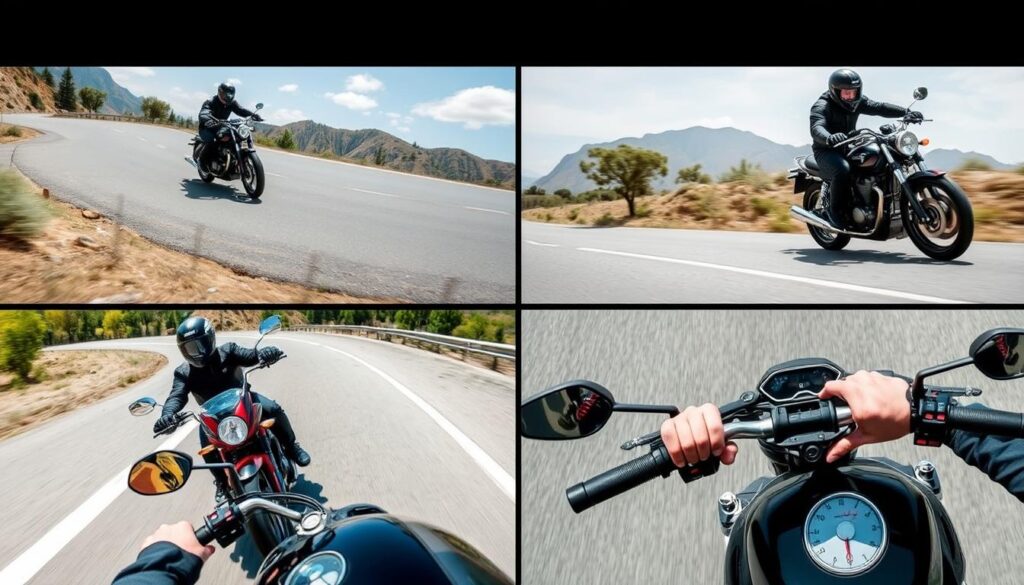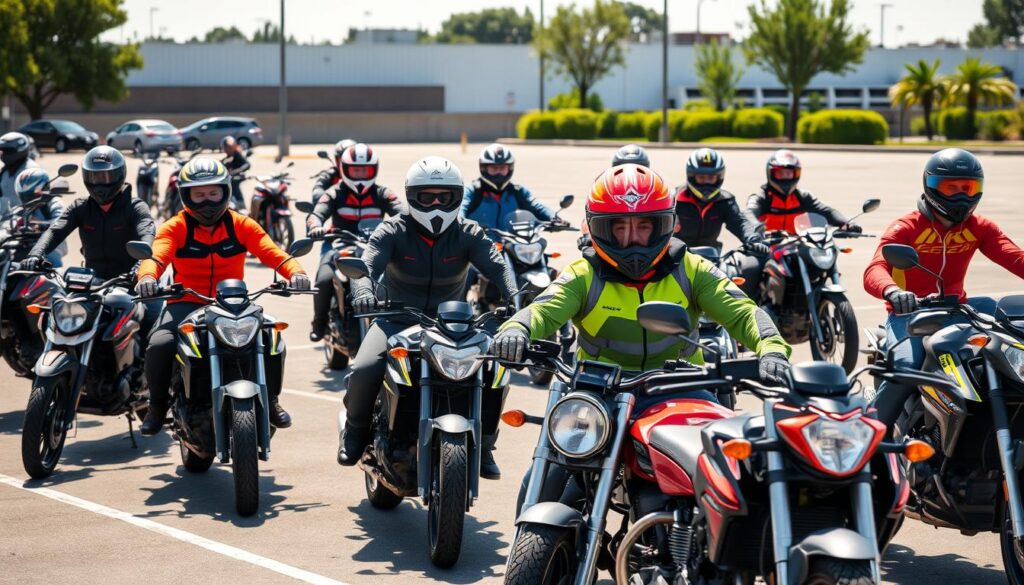Standing in front of your first motorcycle, you feel both excited and a bit scared. The open road calls to you, but you know you must ride safely. Don’t worry, this guide will help you start your motorcycle journey with confidence and skill.
If you’re a seasoned driver or new to motorcycles, this guide is for you. We’ll cover everything from getting your license to learning how to ride and maintain your bike. Get ready, your motorcycle adventure is starting!
In This Guide
Understanding Motorcycle License Requirements
Getting a motorcycle license is a big step for new riders. It might seem hard, but knowing what to do makes it easier. We’ll cover state rules, safety courses, and how to pass tests.
State-Specific Regulations and Documentation
Rules for motorcycle licenses vary by state. It’s key to check your local rules before riding. You might need a learner’s permit, ID, and be a certain age.
Motorcycle Safety Course Requirements
- Many states require a motorcycle safety course before getting a license. These courses teach important skills like braking and cornering.
- Taking a safety course prepares you for the road. It can also lower insurance costs and skip the skills test.
Testing and Certification Process
To get your license, you must pass a written and skills test. The written test covers traffic laws and motorcycle knowledge. The skills test checks your riding skills. After passing, you get your motorcycle endorsement and can ride legally.
“Proper preparation and a commitment to safety are the keys to becoming a confident and responsible motorcycle rider.”
Essential Safety Gear for New Riders
Riding a motorcycle is thrilling but risky. As a new rider, it’s key to wear the right safety gear. This keeps you safe and comfortable on the road. Here’s what every beginner should have.
Helmet
A DOT-approved helmet is the most critical safety item. It protects your head in crashes and keeps your face safe from wind and debris. Make sure it fits well and is always on tight.
Motorcycle Jacket
A tough, abrasion-resistant jacket is essential. Look for one made of leather or heavy-duty materials. It protects your body in falls or collisions. Many jackets also have built-in armor for extra safety.
Gloves and Boots
Your hands and feet are at risk in accidents. So, protective gloves and boots are a must. Gloves offer grip, impact protection, and keep your hands warm. Boots prevent ankle and foot injuries.
Eye Protection
Eye protection is crucial, whether you wear a full-face helmet or an open-face one. High-quality goggles or a helmet face shield keep your eyes safe from wind and debris.
Wearing the right safety gear makes riding safer and more enjoyable. It reduces the risk of serious injury in accidents. With the right gear, you can ride with confidence and safety.
| Gear Item | Key Features | Importance |
|---|---|---|
| Helmet | DOT-approved, snug fit, secure fastening | Protects head, shields face from wind and debris |
| Jacket | Abrasion-resistant, built-in armor/padding | Protects torso, arms, and shoulders in a crash |
| Gloves | Provides grip, impact protection, insulation | Safeguards hands from injuries |
| Boots | Sturdy, ankle-high design | Prevents ankle and foot injuries |
| Eye Protection | Goggles or face shield | Shields eyes from wind, bugs, and debris |
First Motorcycle Guide: Choosing Your Initial Bike
Finding the right first motorcycle can seem tough. But, with the right tips, you can pick the perfect bike for you. Experts say start with a bike that has an engine size between 250cc and 500cc. These bikes are light and easy to handle, perfect for beginners.
Engine Size Considerations
The engine size of a motorcycle is key to its performance. Bikes with engines between 250cc and 500cc are great for new riders. They have enough power for city rides and light highway trips. This makes them a top pick for those new to motorcycle selections.
New vs. Used Motorcycles
Choosing between a new or used bike is a big part of your first motorcycle guide. New bikes have the latest tech but cost more. A well-kept used bike can save you money and still teach you the basics.
Popular Beginner-Friendly Models
Some bikes are especially good for new riders. The Honda Rebel 300, Kawasaki Ninja 400, and Yamaha MT-03 are favorites. They have low seats, easy power, and handle well, helping beginners learn.
Choosing your first motorcycle is a personal choice. It depends on your goals, budget, and comfort level. By looking at engine size, new vs. used, and beginner models, you’ll find the first motorcycle guide that’s right for you.
Basic Riding Techniques and Controls
As a beginner motorcyclist, learning the basics is key for safe riding. This guide will help you understand the essential skills for your motorcycle.
Throttle Control
Smooth throttle use is vital for riding. Practice opening and closing it slowly for smooth speed changes. Avoid sudden throttle moves to prevent jerks or loss of control.
Braking Techniques
Braking right is crucial for beginner motorcyclists. Learn to use both brakes gently, increasing pressure to slow down. Don’t brake too hard, as it can lock the wheels and lose control.
Clutch Operation
Knowing how to use the clutch is key for smooth gear changes. Practice using the clutch and throttle together for smooth transitions between gears.
Basic Maneuvers
Get good at basic motorcycle moves like turning and lane changes. Practice in a safe area, focusing on balance and control.
| Riding Technique | Key Considerations |
|---|---|
| Throttle Control | Gradual, smooth operation for acceleration and deceleration |
| Braking | Coordinated use of front and rear brakes, avoiding sudden braking |
| Clutch Operation | Smooth engagement and disengagement for gear changes |
| Basic Maneuvers | Turning, lane changes, and u-turns with balance and control |
Mastering these riding techniques will boost your skills and confidence. Remember, practice is key. Start in a safe area before riding on the open road.

Understanding Motorcycle Maintenance Basics
As a new motorcycle rider, it’s key to know the basics of maintenance. This ensures your bike lasts long and runs well. Knowing how to care for your motorcycle helps you ride safely and reliably.
Regular Service Intervals
Following your motorcycle’s service schedule is vital. This includes oil changes, air filter swaps, and checks on brakes, suspension, and electricals. Regular maintenance stops small problems from becoming big ones.
Basic Mechanical Checks
- Check your motorcycle’s fluid levels, like engine oil, coolant, and brake fluid. Make sure they’re at the right levels.
- Look at the tightness of important parts, like handlebars, wheels, and engine mounts. This keeps everything secure and right.
- Examine cables, hoses, and wiring for wear or damage. This is important for your bike’s health.
Tire Care and Pressure
- Check your tires often for wear signs like cracks, uneven wear, or low tread. Replace them when needed.
- Keep tire pressure at the level your owner’s manual says. This improves handling, braking, and fuel use.
- Learn to check and adjust tire pressure with a good tire pressure gauge.
By following these motorcycle maintenance basics, you can keep your bike in great shape. This makes for a safer, more enjoyable ride as a new first motorcycle guide rider.
Building Confidence on the Road
As a beginner motorcyclist, it’s key to feel confident on the road. This confidence is vital for a safe and fun ride. Learning the right mindset and improving your skills can help you face your fears and become better at riding.
Regular practice is a great way to build confidence. Look for empty parking lots or quiet streets to practice. Start with simple tasks like starting, stopping, and turning. Then, make your practice more challenging to get better at handling the bike.
It’s also important to mentally prepare. Imagine yourself riding confidently in different situations. This can help you stay positive and calm when you face real challenges.
Getting used to new places to ride can also boost your confidence. Begin with quiet areas and then move to busier roads. This gradual approach helps you gain the skills and experience needed for more challenging rides.
Building confidence on the road is a journey that takes time and effort. By following these tips, you can become a confident and skilled beginner motorcyclist.

Weather Conditions and Riding Strategies
As a new motorcycle rider, it’s key to know how to handle different weather. This knowledge keeps you safe and makes riding fun. Learning to adjust your riding and gear for all weather is important.
Wet Weather Riding Tips
Riding in the rain needs extra care. Slow down, keep more distance from others, and watch out for slippery spots. Hold the handlebars tight and avoid sudden stops or starts.
Temperature Considerations
Hot or cold weather affects your ride a lot. In heat, drink water, wear light, breathable clothes, and rest often. For cold, wear layers and think about heated gloves or a jacket liner.
Seasonal Gear Adjustments
- Change your riding clothes with the seasons. Use layers in spring and fall that you can add or remove.
- Make sure your bike tires fit the road conditions. Choose deep-tread tires for wet roads or winter tires for snow.
- Get a waterproof outer layer, like a rain suit or jacket, to keep dry.
Knowing about motorcycle safety and riding techniques for different weather helps. You’ll be ready for whatever the weather brings and enjoy riding all year.
Common Beginner Mistakes to Avoid
As a new motorcyclist, knowing common mistakes is key to staying safe. One big mistake is target fixation. This happens when you focus too much on one thing, like a hazard, and steer towards it. To avoid this, keep your eyes scanning the whole road. This way, you can see obstacles coming and stay safe.
Another mistake is not knowing how to position your bike in the lane. Beginners might ride too close to the center line or the curb. Instead, ride in the middle of the lane. This gives you space on both sides and makes you more visible to other drivers.
Lastly, don’t get too confident too soon. Feeling good on your bike is great, but never stop learning. Keep practicing, take safety courses, and stay ready for surprises on the road.


Доступные серверы HP Proliant, Оптимальные условия рассрочки на серверы HP Proliant
стоимость серверного оборудования [url=https://servera-hp-proliant.ru]https://servera-hp-proliant.ru[/url] .
I’m not sure what Area 52 has to do with any of this?